
by Peter Boyles | Apr 23, 2021 | Blasting with Boyles
 Suddenly out of the clear blue of the western sky the COVID-19 pandemic has ended. Hallelujah, Hallelujah, Hallelujah. By now, the entire world knows that by a flip of the Imperial wrist, Major League Baseball’s All-Star Game is coming to Coors Field, a proclamation by our esteemed Emperor Jarius the First.
Suddenly out of the clear blue of the western sky the COVID-19 pandemic has ended. Hallelujah, Hallelujah, Hallelujah. By now, the entire world knows that by a flip of the Imperial wrist, Major League Baseball’s All-Star Game is coming to Coors Field, a proclamation by our esteemed Emperor Jarius the First.
As you now know, social distancing has vanished, bars and restaurants will be open until closing time. There will be no social distancing at a sold-out game because the Emperor has proclaimed it.
There will be no concerns, no state of emergency. Nothing for you to fear. The COVID virus, my friends, is gone.
Now while all of this is being said, it was a laugh out loud funny moment when, the next day, the sub headline in the Drudge Report was “Colorado Next COVID hotspot.” Don’t worry about it. The 2021 All-Star Game is moving from Atlanta to Denver, Colorado.
Joe Biden spoke to ESPN and it’s almost impossible to count the lies that the President proclaimed about what he dubbed “Jim Eagle.” And watching all of this take place, I was totally stunned. There’s been a lot of comparison and analysis by smarter people than me about fact-checking Joe Biden’s claims about Colorado’s election law. I cite the Daily Signal. The Daily Signal has pointed out six claims including registration, on absentee ballots, my personal favorite, the crime to provide water, ending early voting, stopping drop boxes, Jim Crow, and voter ID.
As many of you know anybody who walks up to the will call box to the All-Star Game is going to have to do what? Show ID. When you go to cash a check you have to show ID. When you go to buy a firearm, you have to show an ID and take a background check. When you buy alcohol you have to show ID.
There is no consistency. Major League Baseball had no problem but now I’m asking what will happen when your Colorado Rockies go down and play the Atlanta Braves, a racist city. What’s the difference? What about your Denver Broncos when they play their Atlanta Falcons? Isn’t that state still racist? So it’s ok, but just not for the Major League All-Star game. Note to self, how easily Jared Polis pulled this string and apparently they totally negated Mayor Hancock whose city Denver allegedly is. Hancock doesn’t even show up in any of this for three days. Polis the Emperor takes the box. I believe this is part of the setup as Jared Polis makes his move toward the Presidency.
One of the things the woke media has not yet figured out is Denver’s baseball diamond is named after Joe Coors. You remember him in Ronald Reagan’s kitchen cabinet. He bankrolled Barry Goldwater, bankrolled the Mountain States Legal Foundation, and broke a union strike. How dare they come to that field and play?
So I’ve got some proposals. First let’s rename it Dominion Field. That will satisfy all the woke people. It will be interesting to see who gets to carry the game and how nobody in the Front Range media will touch these things.
I leave you with a quote I came across that cracked me up. When Major League baseball player John Kruk was asked in a conversation in a bar… “So you’re a professional athlete?” Kruk responded, “No, I’m a baseball player.”
Take me out to the ballgame.
— Peter Boyles
by Luke Schmaltz | Apr 12, 2021 | Uncategorized
“This is not elective surgery. The Mall is falling apart.” — Mark Sidell, President of Gart Properties, Downtown Denver
 by Luke Schmaltz
by Luke Schmaltz
The Mile High City’s pride and joy of walkable, large-scale retail commerce is showing its age. This project has been in the discussion and planning phases for at least 10 years, and now, a collective of developers and government agencies have aligned in unanimous agreement that the 16th Street Mall needs an overhaul.
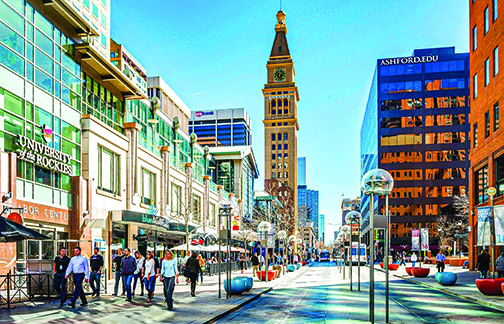
16th Street: Denver’s 16th Street Mall sees incredible foot traffic that has worn it down after nearly 40 years.
This coalescence of groups (primarily) involves the Department of Transportation and Infrastructure (DOTI), Denver Urban Renewal Authority (DORA), the Federal Transit Authority (FTA) and the Downtown Denver Partnership.
The 1.2-mile stretch of walkable commerce and free transport via the RTD MallRide was first opened in 1982. In its inception, the installation was hailed as an unprecedented milestone in urban renewal. The accessible design and pedestrian-friendly layout brought much needed revitalization to a historic yet dilapidated district of run-down tenements, boarded-up warehouses and a pervading sense of imminent danger. While the design has more than served its purpose, wear and tear and the ever-shifting tide of social trends have made it clear that it’s time to streamline the layout for a more user-friendly look and feel.
A Popular Destination
The Downtown Denver Partnership reports (in recent years, pandemic notwithstanding) the 16th Street Mall sees an average of 20,000 pedestrians per day. Meanwhile, the RTD MallRide carries anywhere between 25,000 and 39,000 passengers per day. This sort of traffic takes its toll, as the signature granite pavers used to give the mall its distinctive look must be replaced frequently. This creates an economic strain of around $1 million per year across 75 or so days of maintenance. These large stone blocks were originally rated for a 30-year lifespan underfoot, so many of them have outstayed their tenure.
Streamlining Transit
The prevailing feature the redesign addresses is the areas between the RTD buses which travel up and down the mall at regular intervals
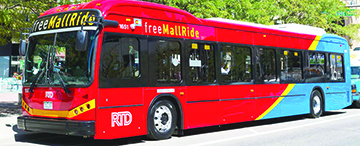
MallRide: The RTD Free MallRide transit bus lanes will be consolidated to create more sidewalk room.
, especially the six-foot stretch between Broadway and Tremont and the 14-foot stretch between Tremont and Arapahoe. With particular reference to the latter measurement, this no-man’s land of abandoned chess tables, exhaust-choked planters and mumbling stumblebums used to be a quaint space for gathering, enjoying shade and sitting down for a rest between shopping sessions.
Due to the increasing frequency of MallRide traffic, these “between zones” have been relegated to underused areas rather than celebrated gathering spaces. It has also been unanimously concluded that, by placing the RTD transit lanes in proximity side by side, a much larger pedestrian sidewalk area can be created. This will reduce congestion, increase foot traffic volume and potentially boost commerce in the long run.
Mark Sidell, President of Gart Properties, which includes the Denver Pavilions and several dozen retail spaces on the mall, sees
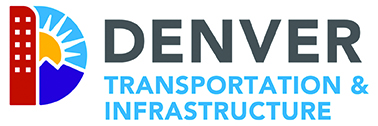
Spearheading: The Denver Department of Transportation and Infrastructure is spearheading the Mall’s improvement project.
the project as a design upgrade that will offer an attractive array of benefits and opportunities. “Think of the mall as one big hallway,” he begins. “The redesign will transform it to a hallway with a living room on either side.” Sidell is referring to some of the as-yet undivulged design ideas which will include gathering spaces, performance areas, extended patio zones for restaurants and bars, and places for retail kiosks. In essence, consolidating the RTD MallRides in the “between zones” is going to make a world of difference.
Out With The Old
In terms of infrastructure, the proposed improvements will address and correct several long-standing issues. First, a 200+ year-old drainage system will be replaced with modern engineering, new trees will be planted along either stretch of sidewalk and new pavers will be installed up and down the entire length of the street in a pattern similar to the current design.
On January 21st of this year, the City of Denver announced it had selected PCL Construction to design and build the new 16th Street Mall. In a recent press release, Eulois Cleckley, Executive Director of DOTI, stated, “We’re thrilled to have reached this latest milestone on this landmark project that improves safety and mobility along the mall and attracts commuters and visitors with interesting new spaces and places for people to enjoy. The contract we present to Council in the coming weeks will reflect a decade of planning and recent input from groups representing business owners, workers, community members and people with disabilities.”
The aforementioned news item also states the project is slated to get underway “… in late 2021 and be completed by the end of 2024.” While the long-term benefits of the remodel are numerous and

PCL: PCL Construction is a familiar presence in the Denver area, and will be the main reconstruction contractor.
far-reaching, the City promises a swath of immediate economic stimulus-like benefits that will counteract the Covid-19-induced recession. These include nearly 1,500 jobs for trades apprentices and skilled laborers, $107M in labor income, $261M in sales (for building materials) and an across-the-board bolstering of the Gross Regional Product (GRP) by some $3.7B.
What Does It All Mean?
While these numbers look great on paper, the big question on everyone’s mind — especially local business owners, service industry workers, retail workers, restaurateurs and patrons — is how will this affect business between the beginning of the project in late 2021 to its projected completion sometime in 2024? Sidell expounds on his understanding of the role the contractor will play during construction; “PCL is charged with always keeping the pedestrian traffic open. You’ll always be able to get through whether you are walking by yourself or with a group and it will be ADA (Americans with Disabilities Act) accessible and I am confident that they will do that,” he explains. “All that said,” Sidell continues, “are you going to want that [construction] in front of your place of business even one day longer than it has to be? No, of course not. However, it is construction that is going to be conducted in a way that has been very thoughtfully planned out. They have placed a high priority on maintaining access, safety, signage and keeping businesses open.”
A transparent approach has been orchestrated through a series of meetings between project planners and local retailers, property owners, restaurants and the general public. “They’ve done a great job of getting a lot of public interest into the project because everybody has a different perspective and it’s important to get the input of all mall users.” He says. “I am pretty optimistic about what the other side will be … I am confident that a lot of really smart people are working on it, but I’m a realist — it’s still construction.”
The Show Must Go On
Construction in public areas almost always means detours, and this project is no exception. Julie Smith, Director of Communications for the City of Denver Department of Finance explains, “The Free MallRide shuttle will continue to serve the Mall area throughout construction. In active construction zones, the MallRide will be detoured to 15th or 17th (depending on the direction) which both have dedicated bus lanes which can accommodate the MallRide’s frequent stops without disruption to other vehicular traffic. Also, the RTD MallRide will operate on the Mall normally for the blocks that are not under active construction.”
Her office assures that business and leisure on the mall will still be underway throughout construction. She states, “Mai

Baskets: Cindy Kent of A la Carte Flowers and Baskets is determined to weather yet another storm.
ntaining continuity and predictability for the traveling public during construction is extremely important to the project. As the contractor moves from design into construction, we have a systematic process in place to control the construction work and minimize the overall impact to the community. Safe, pedestrian access to businesses and residences will be maintained throughout the project.”
Through Thick And Thin
Meanwhile in the Mall’s private business sector, Cindy Kent is the owner of A la Carte Flowers and Baskets and she is persevering through a year that has put many of her neighbors out of business. When asked about how she thinks construction will affect businesses on the mall, she responds with the exuberant laugh of a business owner who has a healthy sense of skepticism. “The biggest challenge on the Mall right now is parking,” she begins. “I have a paid parking spot because it is an absolute necessity. But my drivers are constantly looking for parking, so construction is going to no doubt drive my rates up.”
A former member of the Downtown Denver Partnership, Kent explains, “I have been hearing rumors of this project for the 20 years I’ve been in this location” (910 16th Street Mall #312). “It’s not egregious enough that we just went through what we went through,” she continues, “We are on the heels of barely coming back in the fourth fiscal quarter and this is their timing?” Regardless, Kent’s 25th anniversary of being in business is coming up, and she’s as determined as ever to weather yet another large-scale disruption. “I get that is finally underway,” she quips, “But I’m really just rolling my eyes at this point.”
by Luke Schmaltz | Apr 12, 2021 | Uncategorized
- “From the greatest of horrors irony is seldom absent.” P. Lovecraft
 by Luke Schmaltz
by Luke Schmaltz
Irony’s flag flies at full mast at the Suncor Energy refinery in Commerce City, Colo. The industrial behemoth is located just north of Denver’s city center and just east of the confluence of I-70 and I-270. The company bears a name that conjures images of an eco-friendly solar energy entity — perhaps working to reduce carbon emissions by developing sustainable alternatives to fossil-based energy sources.
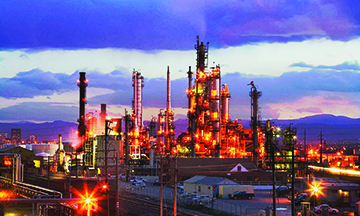
Suncor’s warm glow has a net worth of over $28 billion.
However, Suncor Energy has amassed a collection of over 100 violations for exceeding toxic emission levels — just in the last five years. Across the 230-acre complex, a toxic cocktail of gasses is continuously released not only from smokestacks, but from gas flares, storage tanks and pressure release devices. These include hydrogen cyanide, sulfur dioxide, benzene, carbon monoxide, nitrogen oxides, and particulate matter — among other delights. Recently, the Colorado Department of Public Health and Environment (CDPHE) reached a “historic” $9 million settlement for emissions violations. When released into the atmosphere, these pollutants trap the sun’s heat, causing the greenhouse effect. At least, from this angle, the company’s name is accurate — if only ironically.
An Unmistakable Aroma
If you have lived in Denver for any length of time, you know how it goes: One warm sunny afternoon you’re cruising east on I-70 toward Central Park, and a nauseating waft of gag-inducing smog rushes through your car windows like puke breath from a giant invisible dog. Buckle up for more irony, because even though the stench is making you gasp, there’s at least a 30% chance that the fuel in the car you are driving was refined in this industrial pariah you so revile. Also, if you happen to be heading to the airport to catch a flight, your interdependence deepens as Suncor refines much of the jet fuel used at DIA. But wait, there’s more: chances are good that the asphalt you are driving on was produced at this site as well. More truth in advertising — at least for airline travelers — as the fossil fuels refined

The fuel you use to drive past Suncor may have been refined in the same location.
by Suncor are literally used to take you closer to the sun.
As far as polluters go, Suncor is one of the top producers of carbon emissions with a track record of frequent malfunctions including a recent incident when an “operational upset” released a plume of yellowish debris into the air which wafted across the area and landed on outdoor surfaces throughout the district. According to an article by The Denver Post, the 89-year-old facility releases 866,100 tons of fumes per year. This has earned the surrounding communities of Globeville and Elyria-Swansea the title of “The Most Polluted Zip Code in the Nation” (80216) — according to a 2018 survey conducted by ATTOM Data Solutions.
Follow The Money
Accolades notwithstanding, Suncor’s net worth, or that of its Canadian parent company is recorded by Macrotrends.net to be at an estimated $28.18 billion.It pays $14 million (average) in annual taxes paid to Commerce City and Adams County but gets $2.3 million in tax credits the refinery receives for operating in an “enterprise zone.” The Oxford dictionary defines this as “An impoverished area in which incentives such as tax concessions are offered to encourage business investment and provide jobs for the residents.” While the title is ambiguous, the definition is spot-on. The districts surrounding the Suncor facility are some of the lowest-income areas in the region. Residents are almost universally opposed to the refinery, attributing decades of health issues to the constant presence of toxic fumes.
According to a March 2020 article by CBS4, $4 million of that settlement is allotted for penalties and community projects while $5 million is “… for Suncor to hire a third-party company to investigate why its facility continues to have problems and implement recommendations from that investigation.” So, essentially, they have to pay a fine that they reap the rewards from. They are, essentially, being forced to give concessions

Unless Denverites quit driving and flying, Suncor will not be departing anytime soon.
to the community and to fix their own problem using the money they are being “fined” for.
Old Habits Die Hard
While some are calling for the refinery to be shut down, the measure carries another hidden, ironic caveat. Were that to happen, the pipeline through which the crude oil is transported to Colorado from Alberta, Canada, would have to be replaced by diesel engines from large semi-trucks so that DIA could continue to operate. This, in turn, would create possibly even more carbon emissions than the refinery is currently generating. So, unless Denverites plan to curtail the need for air travel, gasoline and asphalt, it looks as though it’s going to be business as usual.

by Luke Schmaltz | Mar 19, 2021 | General Featured
“The number one rule of thieves is that nothing is too small to steal.” – Jimmy Breslin
 by Luke Schmaltz
by Luke Schmaltz
A large number of Denver residents are sitting on top of a hidden treasure and they don’t even know it.
Below the interior cabs of all modern cars, along the vehicle’s undercarriage parallel to the driveshaft, sits the exhaust system in a series of pipes, gaskets and couplings. Within this assembly, for all cars made after 1975, is a catalytic converter — a filter which transforms harmful exhaust compounds (hydrocarbons, nitrogen oxide and carbon monoxide) into inert gases.
This piece of automotive technology contains semi-precious metals which are crucial to the catalyzing process. These include palladium, rhodium and platinum — rare metals that are sought after and valued on par with gold. It is no secret to enterprising thieves that these components can fetch between $150 and $300 per unit from scrap yards and chop shops — and sometimes even more.
Amid the economic hardship of the past year, the risk-to-reward ratio of catalytic converter theft is attractive enough for someone with a few tools and nothing to lose to take action. Anyone with enough nerve and a bit of know-how can simply crawl beneath a car in the middle of the night and start hacking away. Vulnerable cars are everywhere — parked

Theft On The Rise: Catalytic converter theft is up 1600% in the Denver area from 2019.
on the street, in parking garages, strip malls and driveways. As jobs disappear, pandemic relief runs out, and perhaps a bad case of cabin-fever boredom takes hold — car part pirates set out to find their livelihood amid a vast urban landscape abundant with low-hanging fruit.
The number of thefts across Denver is on the rise like the temperature gauge on an overheating vehicle. In 2019, a total of just 15 were reported, while in 2020, the cases jumped up to a staggering 257. Meanwhile, 2021 is on par to leave that number in the dust, as 108 cases of stolen catalytic converters were reported by the end of January.
The Winners
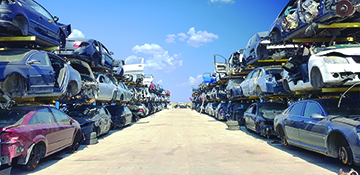
Junkyard: Catalytic converters make a quick stop at a place like this so the precious metals therein can be removed.v
Experienced thieves who know where to slither and hack can get away with half a dozen or more converters per night. Doorbell cameras have captured these heists taking place with alarming speed — some in under two minutes. Once these are sold to a scrap yard or fenced to a black-market processing facility, the thief makes a few bucks and the next guy (the fence) digs into the devices, harvests the precious metals therein and sells them to a dealer. While laws are in place that supposedly forbid scrap metal dealers and junkyards from accepting stolen goods, there is by no means a task force monitoring these markets. If thieves are bold enough to break the law in plain sight, what’s to stop them from continuing to do so until the valued goods find their way back into the supply chain?
Next in the catalytic converter economic stimulus line are the auto repair shops. As this is becoming a routine procedure, the parts can be replaced with a fair degree of quickness and ease. Yet, parts and labor cost money and even if the mechanic is an honest one, they’ll be billing each client anywhere from $1,000 to $3,000 per job.
The Losers
The victim’s experience is invariably the same. A vehicle owner gets in their car, turns the ignition key to start the engine and is jolted upwards by a roaring blast of exhaust from beneath. In previous years, the individual may have thought it was just a temperamental automotive glitch that would work itself out. More recently, however, a person in this scenario quickly comes to the harrowing realization that part of their car has been stolen right out from underneath them.
After a sputtering, cantankerous trip to the mechanic, they are hit with a repair bill that most likely places yet another degree of economic strain on an already dire situation. While folks with comprehensive insurance coverage can send the bill to their carrier, a great many drivers out there do not have such coverage because they are trying to save money, and when they bought their insurance, rampant car part theft was probably not yet on their radar.
The Also-rans

Catalytic Converter: If you want to keep your catalytic converter, knowing how to weld is a valuable skill.
The associated fallout of these thefts is the additional burden that is placed on the Denver Police Department. While there is little or nothing that responding officers can do to recover the stolen part, there is considerable strain in terms of the man hours it takes to follow up on every case, to fill out paperwork and to listen to the victims tell their stories.
Enough Is Enough
Across the Mile High City, people are becoming increasingly aware that they could very well be the next victim in line to have their catalytic converters stolen. The obvious solution is to park your car in a garage, lock it up for the night and the problem is solved. The problem with that, is that the vast majority of car owners, especially in neighborhoods near the city center, do not enjoy such luxuries.
High profile vehicles like SUVs, Hummers and 4×4 trucks are the easiest targets, as they do not need to be jacked up off the ground in order for the thieves to access the converter. A smart driver on a shoestring budget can opt to park their Prius between a Ford F-250 and a Land Rover and hope their neighbors bear the brunt of the thievery instead of them.
Proactive citizens can sit up all night and guard their cars with a flashlight and a baseball bat. Yet, most people enjoy their sleep and do not wish to confront criminals in the pale moonlight. Thankfully, this scourge of theft has necessitated a suite of new inventions designed to keep your catalytic converter attached to your car’s exhaust system and out of the hands of criminals. In yet another economically beneficial outcome of the rise in theft, these devices range anywhere from $125 to $700 or more apiece, plus installation if you’re not handy with tools. These products are carving out a market niche for themselves under names such as The Cat Clamp, Cat Security, Cat Strap and more.
- Cat Strap: This alarm-style device features contact and motion sensors. The strap is tethered along the length of the exhaust system (which includes the catalytic converter) by a series of metal clamps and rings. The sensor is then wired to the battery and the alarm receiver is mounted beneath the hood. Contact with the exhausts system or significant motion beneath the car in the vicinity of the catalytic converter will set it off. Thief activity beneath your car sets off the alarm, which then deters the perpetrator. Professional installation is recommended.
- Cat Security: This device is strictly hardware, and acts as a type of shield between your catalytic converter and the ground. The product is essentially sheet metal which is pre-fabricated to fit the undercarriage of specific models of cars. The shield is then bolted into place with a combination of security rivets, bolts and self-tapping screws. The protective barrier is immediately obvious to and should convince most thieves to think again. Professional installation is optional.
- Cat Clamp: Another hardware-based product, this invention uses braided, heavily-rated steel cables and heavy-duty steel clamps and adaptor plates which, once mounted and installed, surround your catalytic converter in a metal cage. The various product sizes can accommodate everything from regular sized cars to large, heavy duty diesel trucks. Hardware and cable run the length of the exhaust system and present an immediate visual deterrent to thieves — as it is obvious the catalytic converter is not coming off without a whole lot of effort and noise. Professional installation recommended.
Extreme Measures
A similar approach is to have the catalytic converter welded to your car’s frame, which would make it much harder and far more time consuming to steal. Another method is to have your car alarm system recalibrated to detect the subtle humming of a reciprocating saw or the light tog of a ratchet wrench. Other folks are engraving their car’s VIN number to the housing on the converter, which to an average thief might be a deterrent, but to an enterprising criminal — it might be an invitation to pursue identity theft.
The other options are to string barbed wire around your car every night and risk getting cited for littering or reckless endangerment. You could train rattlesnakes to coil up in the undercarriage at night and take a swipe at anything that crawls under the car. Or you could just sell the damn thing and get a bike — along with an arsenal of four or five heavy duty U-locks.

 Suddenly out of the clear blue of the western sky the COVID-19 pandemic has ended. Hallelujah, Hallelujah, Hallelujah. By now, the entire world knows that by a flip of the Imperial wrist, Major League Baseball’s All-Star Game is coming to Coors Field, a proclamation by our esteemed Emperor Jarius the First.
Suddenly out of the clear blue of the western sky the COVID-19 pandemic has ended. Hallelujah, Hallelujah, Hallelujah. By now, the entire world knows that by a flip of the Imperial wrist, Major League Baseball’s All-Star Game is coming to Coors Field, a proclamation by our esteemed Emperor Jarius the First.











